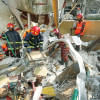How to prevent another chemical tragedy from happening

On the night of June 4, 2022, explosions occurred at the Sitakunda container depot in Chittagong, resulting in the loss of fifty-one lives. We witnessed the fire and explosions through live-streaming on social media, hearing people crying. What caused this explosion and fire that lasted for three days spreading over several kilometers? The answer lies in the dangerous hydrogen peroxide gas. However, are such events new? Not really. In 1984, in Bhopal, India, our nearest neighbour, the Union Carbide factory released toxic methyl iso-cyanide gas, causing the immediate death of 3,000 to 8,000 people, with a total toll of twenty thousand after the accident.
Alternatively, we can examine the 2015 explosion at a container depot in China's Tianjin seaport. This explosion, similar to the one in Bangladesh, claimed one hundred and seventy-four lives. There too were stockpiles of ammonium nitrate, along with the presence of sodium cyanide and calcium carbide, commonly used in fertiliser manufacturing. Or, let's talk about the biggest non-nuclear explosion in history, that resulted in 218 deaths, 30,000 refugees, and the destruction of 77,000 apartments in Beirut in August 2020 for which 2750 tons of ammonium nitrate stock was also responsible.
Each incident shares a similarity: toxic or hazardous chemicals! These substances are essential yet perilous for human life. For example, hydrogen peroxide is used as a cleaner and disinfectant, while ammonium nitrate is widely used in agriculture as a nitrogen fertiliser, and methyl iso-cyanide is used as an agricultural pesticide.
Think, if we had used safe alternative chemicals instead of these dangerous ones, would this loss of life have happened? Certainly not. Hence, before implementing scientific discoveries in human life, awareness of both their benefits and risks is essential.
However, history tells a different tale. For instance, scientist Carl Wilhelm Scheele, credited with discovering fluorine, manganese, barium, and nitrogen, tragically died from exposure to hydrocyanic acid. Humphrey Davy, another notable scientist responsible for the discovery of one-fifth of the elements we know, met his end due to exposure to nitrous oxide. Marie Curie, a Nobel laureate renowned for discovering radioactivity, succumbed to leukaemia after exposure to harmful radiation. Interestingly, her laboratory notebook from 1890 is preserved in a lead box, requiring protective clothing for viewing. Rosalind Franklin, who played a vital role in unravelling the structure of DNA but did not get recognition for her work during her lifetime, also passed away at the age of 37 from exposure to her research device.
Numerous scientists have lost their lives due to hazardous chemicals. We cannot call them careless because they were enthusiastic about invention and wanted to discover something that could be applied to human welfare. They had no idea at that time that any molecule or compound could be dangerous or poisonous. However, the swift advancement of industrialisation redirected attention towards enhancing productivity. The use of any type of chemical to increase production is augmented. But no one is as concerned about the harmful side of those chemicals. That's where green chemistry comes in. It is a chemical product or process designed in such a way that it eliminates or reduces hazards to humans, plants, and the environment.
Green Chemistry aims to reduce or eliminate the use and generation of hazardous substances by ensuring the safe production, synthesis, and utilisation of various chemical substances or materials. Scientist Paul Anastas, formerly a staff chemist at the US Environmental Protection Agency (EPA), coined the term 'green chemistry' in 1989. He is now a Professor and Director of the Center of Green Chemistry and Green Engineering at Yale University. In 1996, Anastas co-authored the pioneering book 'Green Chemistry: Theory and Practice' with his childhood friend and classmate John Warner, earning him the title of the father of green chemistry.
Green chemistry, a discipline within chemical engineering, integrates pollution prevention and zero-waste concepts into laboratory and industrial practices while concurrently enhancing economic profitability and productivity. It focuses on reducing or eliminating potential hazards of substances, products, or processes in their initial design phase. The role of organic chemists is to discover new compounds, and green chemistry scrutinises these molecules for potential hazards to safeguard humans, plants, and the environment.
The adoption of green chemistry in research and industries worldwide is on the rise. For instance, biofuel is being produced from green algae. These specific algae can convert over 80 percent of photosynthetic carbon into ethanol, leading to a 15-20 percent production increase compared to conventional methods. Biofuel was previously produced from corn. Their skills are equivalent to planting 40 million trees or removing 36,000 cars from the road. Thus, green chemistry is revolutionising the industry. Applying green chemistry can change our world, and ensuring its proper use is essential to make all products and things around us eco-friendly. This approach is crucial for building a safer and habitable world.
Md Mokarom Hossain, is a scientific officer at the Bangladesh Council of Scientific and Industrial Research.
Views expressed in this article are the author's own.
Follow The Daily Star Opinion on Facebook for the latest opinions, commentaries and analyses by experts and professionals. To contribute your article or letter to The Daily Star Opinion, see our guidelines for submission.

 For all latest news, follow The Daily Star's Google News channel.
For all latest news, follow The Daily Star's Google News channel. 










Comments